Have you ever seen a chef on TV, effortlessly slicing vegetables or meat with a super sharp knife? It looks like magic, right? Well, behind that magic is often a really good knife. And today, I’m going to tell you all about some amazing knives made right here in America: Lamson knives!
Imagine a company that started making knives way back when your great-great-grandparents were kids – that’s Lamson! They’ve been crafting knives in Massachusetts, USA, since 1837, to be exact. That’s even older than sliced bread! They are actually the oldest cutlery company in the whole United States. How cool is that?
In this super guide, I’m going to explore everything about Lamson knives. I’ll look at what makes them special, what kinds of knives they make, how well they cut, and even compare them to other popular knives you might have heard of. So, get ready to become a knife expert – I promise it’s going to be fun!
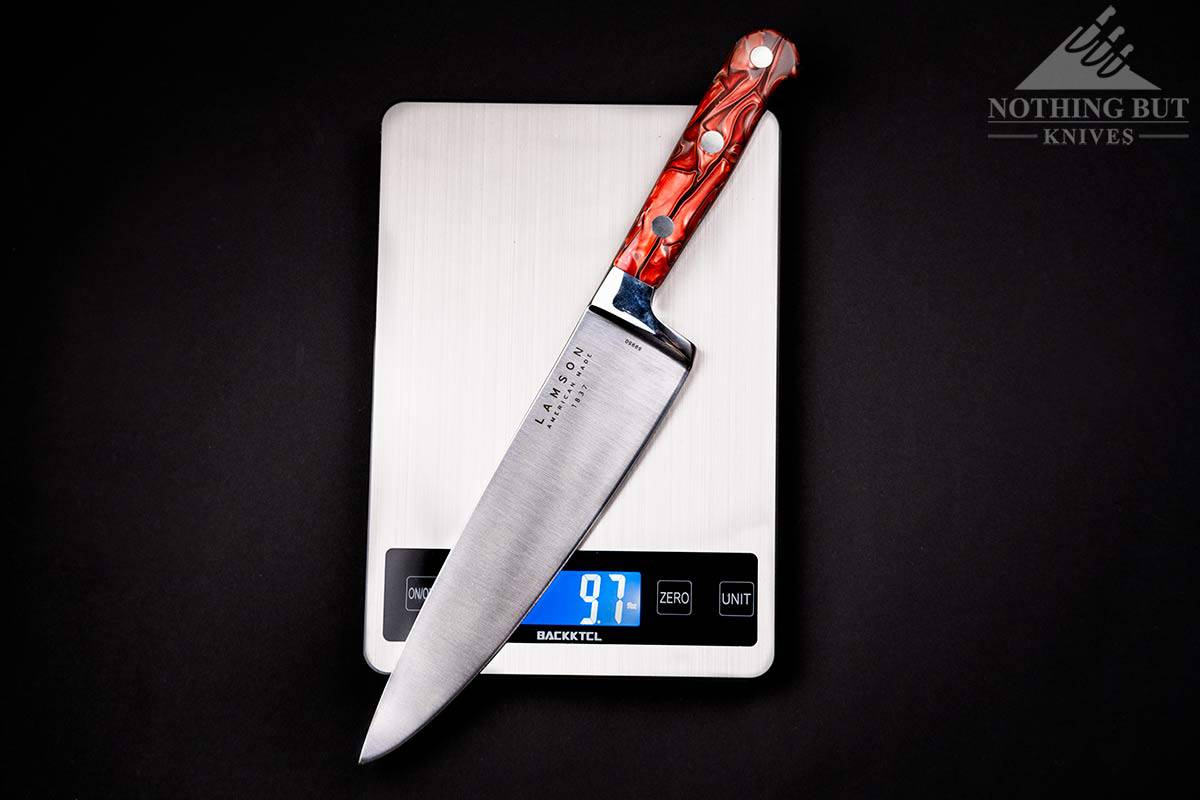
My Introduction to Lamson: What Sets Them Apart?
So, what makes Lamson knives so special? Well, for starters, they’re not just any knives. They are like the grandpas of American knives! Lamson has been making high-quality cutlery in Massachusetts, USA, for over 180 years. Just think about all the meals that have been prepared with a Lamson knife in that time!
Why I Think You Should Choose Lamson
You might be wondering, with so many knives out there, why I think you should pick a Lamson? Here are some really good reasons I’ve found:
- Made in America: If you like supporting things made in your own country, Lamson is a great choice. Every single knife is made with care in the USA. I appreciate knowing where my tools come from.
- Super Quality Materials: They use really good steel and strong materials for the handles, which means their knives are built to last a very long time. I like things that are built to endure.
- Lifetime Warranty: This is a big one! It means Lamson believes so much in their knives that if something goes wrong because of how they made it, they’ll fix it or replace it. It’s like a promise that your knife will always be awesome, and I love that kind of assurance.
- “Sharp for Life” Program: Imagine sending your knife back to the people who made it, and they sharpen it for free! Lamson offers this, which I think is fantastic because a sharp knife is a happy knife (and a safer knife!).
- Beautiful Designs: Lamson knives aren’t just useful; they’re also beautiful. I find their classic looks can make any kitchen feel extra special.
Lamson makes different “families” or “series” of knives, each with its own special look and feel. I’ll explore these families in a bit, but just know that whether you like a heavy, sturdy knife or a lighter, more elegant one, Lamson probably has something for you.

Lamson Knife Series Overview: Meet the Knife Families!
Just like a family has different people with different personalities, Lamson has different knife series, each with its own unique characteristics. Let’s meet them!
Lamson Premier Forged Series: The Strong and Sturdy One
Imagine a strong, dependable superhero of a knife. That’s how I think of the Premier Forged series! These knives are made using a special process called “forging.” Think of it like a blacksmith hammering hot metal into shape. This makes the knife super strong and durable.
Materials and Construction
The blade is made from German high-carbon stainless steel. This means the steel is very tough, stays sharp, and won’t get rusty easily. These knives also have something called a “full tang” and a “full bolster.”
- Full Tang: The metal of the blade extends all the way through the handle. This makes the knife super strong and balanced. I really appreciate this for a sense of security while cutting.
- Full Bolster: This is the thick part of the knife where the blade meets the handle. It makes the knife feel really solid in your hand and protects your fingers from slipping onto the blade.
Target Audience
If you like knives that feel solid and a bit heavy, like traditional German knives, then the Premier Forged series is perfect for you. I’ve noticed that many chefs and serious home cooks often love these.
Key Features and Benefits
- Durability
- Balance
- Good Edge Retention
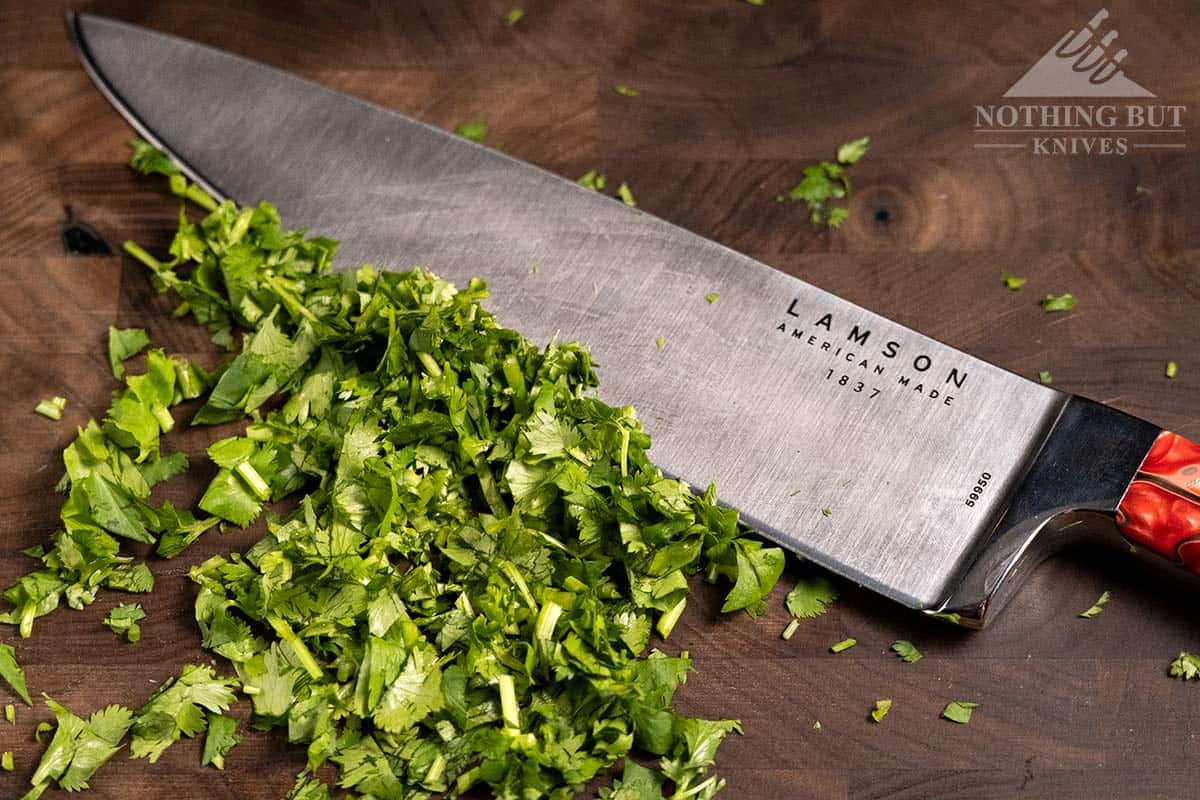
Lamson Vintage Precision Series: The Elegant and Nimble One
Now, if the Premier Forged is the strong superhero, I’d say the Vintage Precision series is like a graceful dancer. These knives are often lighter and have a more classic, elegant look. I find them great for people who prefer a knife that feels a bit quicker and easier to move around.
Materials and Construction
The blades are made from Swedish stainless steel, which is known for being very sharp. Unlike “forged” knives, these are often “stamped,” meaning they are cut from a sheet of steel. This makes them lighter and often a bit thinner. The handles often come in beautiful materials like rich Walnut wood, giving them a timeless look that I personally adore.
Target Audience
If you like knives that are lighter in your hand and have a classic, beautiful design, the Vintage Precision series is for you. I think they are fantastic for everyday kitchen tasks.
Key Features and Benefits
- Great Ergonomics
- Excellent Sharpness
- Timeless Look

Lamson Noir Ultra Durable / Presidential Pink Series: The Modern and Colorful One
These knives are a bit more modern and, as the name suggests, super durable! I’ve noticed the handles are often made from special materials that are incredibly tough and easy to clean.
Unique Handle Materials
The Noir series often uses a material called POM (polyoxymethylene). It’s a super strong, heat-resistant plastic that won’t absorb smells or germs. The Presidential Pink series, for example, is part of this family and has bright, fun pink handles!
Benefits
I think these handles are amazing because they are durable and hygienic.
Collaborations
Sometimes, Lamson partners with other cool brands, like Great Jones, to make special knives. I think this shows how versatile and popular Lamson knives are!
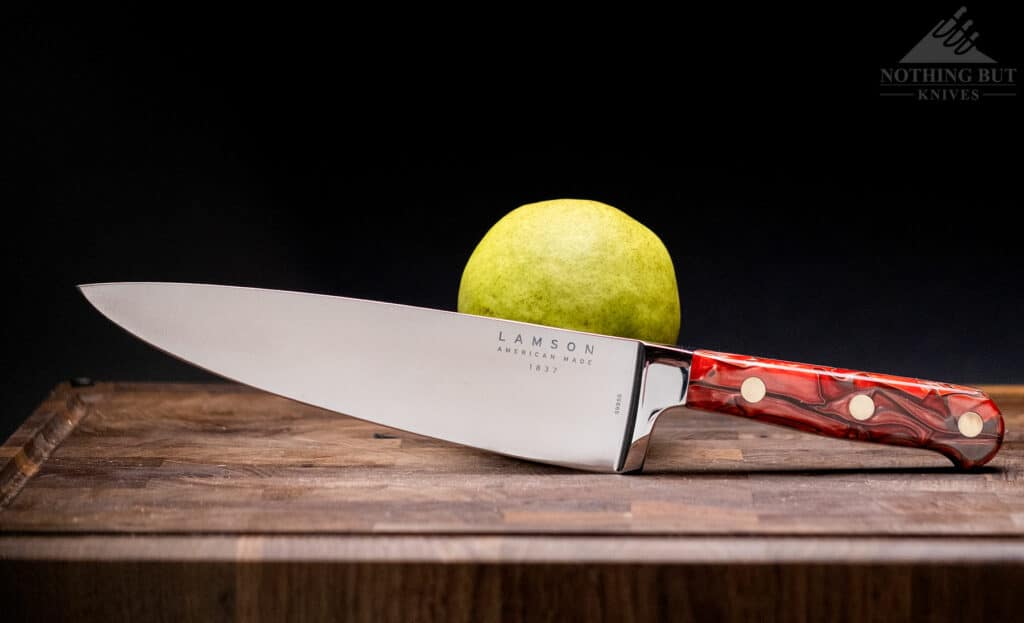
Lamson Brad Leone Signature Series: The Unique and Fun One
If you’re a fan of cooking videos on the internet, you might know Brad Leone! He’s a chef with a fun personality, and he teamed up with Lamson to create his own special series of knives.
Distinguishing Features
These knives often have unique shapes or special etchings (designs) on the blade. For example, Brad Leone has a famous “Chinese Santoku Cleaver” in his series, which is a mix between a traditional Chinese cleaver and a Japanese Santoku knife. It’s perfect for chopping big veggies or even breaking down a whole chicken.
Appeal
If you love Brad Leone’s cooking style or are looking for a knife that’s a bit different and super versatile, I think this series is a great choice.

My Experience with Performance and User Experience: How Well Do They Cut?
Okay, I’ve talked about what they look like and what they’re made of. But the most important thing for a knife is: how well does it cut?! Let’s dive into that.
Sharpness and Edge Retention: The Cutting Power!
Imagine slicing a tomato so thin you can almost see through it. That’s what a super sharp knife can do!
Out-of-the-Box Sharpness
When I first get a Lamson knife, it usually comes incredibly sharp.
Steel Hardness (HRC)
Knife steel has a “hardness” number (like 58 HRC for many Lamson knives). A higher number means the steel is harder, which usually means it stays sharper for longer. I find Lamson knives generally have a good balance.
Edge Retention
I’ve found Lamson knives do a pretty good job here. They’re not going to get dull after just one use. You can slice and dice for many meals before they need a little touch-up.
Comparison to Other Knife Brands
- Wusthof: Often similar to Lamson Premier Forged.
- Victorinox: Often a bit softer steel, so they might need sharpening more often, but they are also very easy to sharpen.
- Japanese Knives: Often use much harder steel, staying super sharp for a very long time, but they can be more fragile and harder to sharpen correctly. I think Lamson finds a nice middle ground.
Honing and Sharpening
Even the best knives get a little dull. Honing straightens the edge, while sharpening creates a new one. Lamson’s “Sharp for Life” program is fantastic for free sharpening!
Blade Durability and Construction: Built to Last!
A good knife isn’t just about being sharp; it also needs to be strong and tough so it doesn’t break easily. I always look for this in a quality knife.
Blade Materials
Lamson uses strong steels like 4116 German Steel, 12C27 Swedish Stainless Steel, and 420HC-LAM, which are all very durable and resistant to rust.
Corrosion Resistance
All Lamson knives use stainless steel, so they are generally very good at not rusting, as long as you clean and dry them properly.
Full Tang vs. Stamped Construction
- Full Tang (Premier Forged): Super strong, perfectly balanced, great for heavy-duty tasks.
- Stamped (Vintage Precision): Lighter, often thinner blades, can be more nimble for delicate work.
Ergonomics and Comfort: A Joy to Hold!
“Ergonomics” just means how comfortable something feels in your hand. A good knife should feel like an extension of your hand. This is very important to me.
Handle Materials and Their Feel
Lamson uses materials like Walnut, POM, G-10, and Acrylic. I love the feel of the different options.
Handle Shape and Grip
Lamson designs its handles to be comfortable for most hands, whether you prefer a pinch grip or a traditional grip.
Balance and Weight Distribution
Lamson does a great job with balance, making their knives feel natural and easy to control, even during long chopping sessions. I really appreciate this feature.
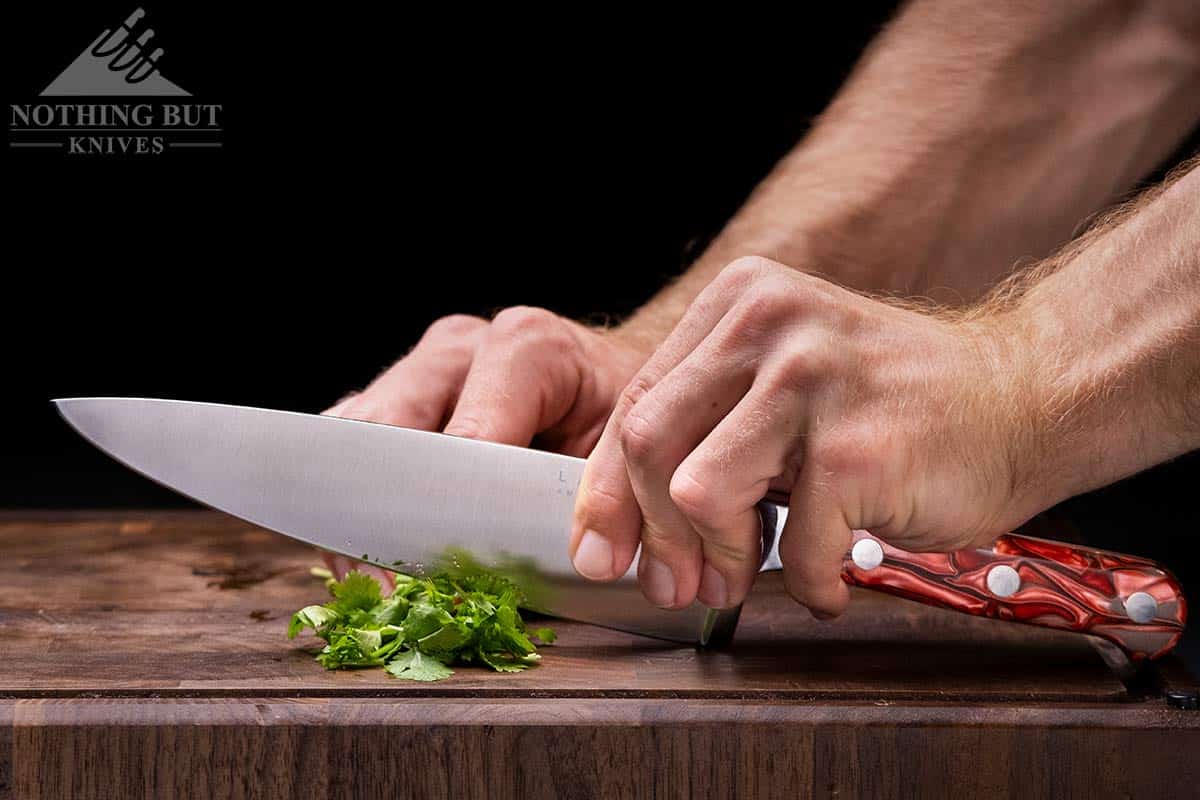
Cutting Performance Across Tasks: The Real Test!
Okay, let’s talk about how these knives actually perform when you’re cutting different things!
Different Knife Types
Lamson makes all sorts of knives, each for a specific job: Chef’s knife, Paring knife, Santoku, Bread knife, Slicing knife, and Boning knife. I find Lamson’s chef knives to be versatile and feel great for general tasks.
Specific Cutting Experiences
I’ve found Lamson knives slice through ripe tomatoes with ease, make dicing onions a breeze, and chop tough vegetables like carrots with little effort. For flexible blades, I’ve found them precise enough for tasks like filleting fish.
In short, I believe Lamson knives are built to perform! They handle a wide range of kitchen tasks with ease, making cooking more enjoyable and efficient.

Pros and Cons of Lamson Knives: The Good and the Not-So-Good
Every product has its good points and areas where it could be even better. Let’s look at the ups and downs of Lamson knives.
Advantages: Why I Think You’ll Love Them!
- Made in the USA: A fantastic choice if American-made quality is important to you.
- Premium Materials and Craftsmanship: High-quality steel and handle materials, with clear care put into making each knife.
- Comfortable and Diverse Handle Options: A variety of comfortable handles to suit different preferences.
- Lifetime Warranty and Sharpening Program: A huge benefit that shows the company stands behind its products and saves you money.
- Good Balance and Durability: Feel solid and balanced, built to last for many, many years.
Disadvantages: Things I Think You Should Consider
- Average Edge Retention Compared to Some Competitors: While good, some Japanese knives might stay sharp for even longer (though they can be more fragile).
- Potential for Minor Quality Control Issues: Very occasionally, some users report minor cosmetic issues (like a slightly uneven grind). Lamson’s customer service is generally excellent for addressing these.
- Price Point Compared to Budget Options: More expensive than basic knives, but a quality investment that will last.
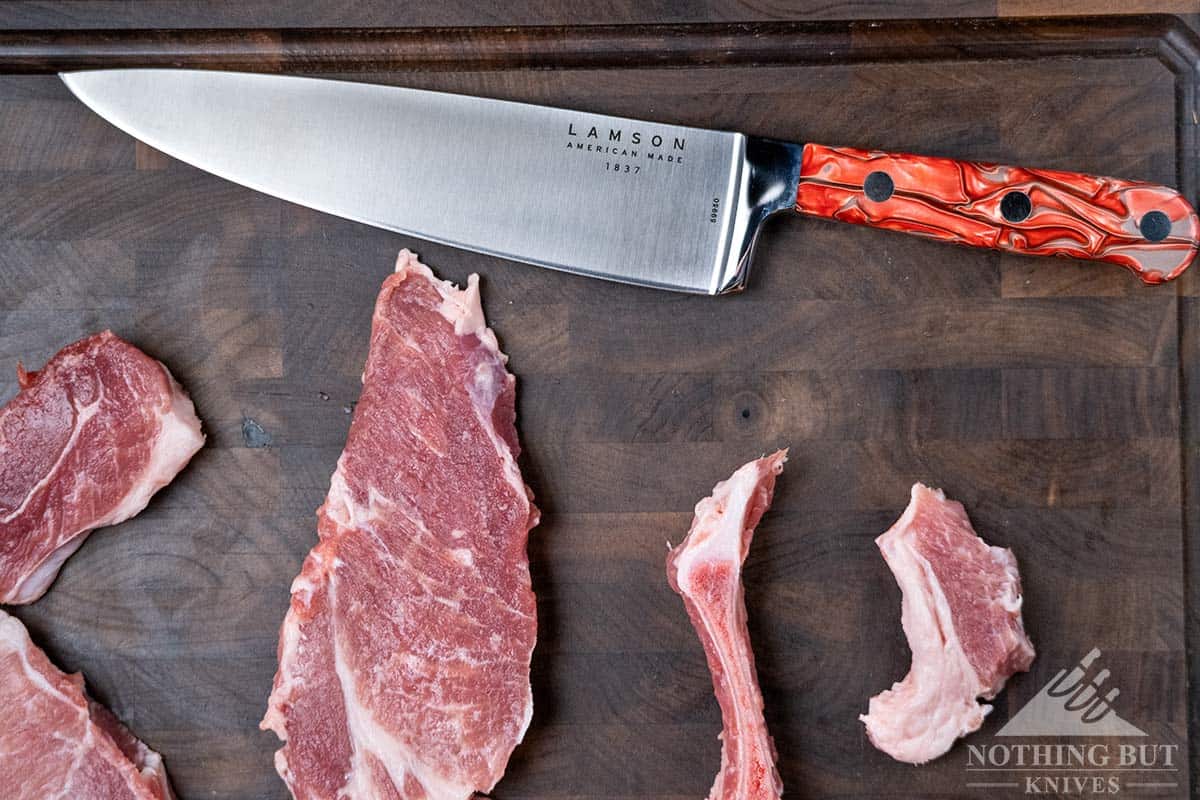
Lamson Knives vs. The Competition: How Do They Stack Up?
It’s helpful to see how Lamson knives compare to some other popular brands out there. I’ll give you my thoughts on the comparisons.
Lamson vs. Wusthof: The German Powerhouses
Both use high-carbon German stainless steel and are known for toughness. They often have similar handle options, weight, and price. I believe Lamson Premier Forged is a very strong competitor to Wusthof, offering excellent quality with the “Made in USA” appeal.
Lamson vs. Victorinox: The Swiss Army Knife of Kitchens
Victorinox often uses softer steel, making them incredibly easy to sharpen but needing it more often. They are generally more affordable. While Victorinox offers great value, I think Lamson provides more durability and a premium feel.
Lamson vs. Japanese Knives: The Precision Cutters
Japanese knives often have thinner, steeper blades for precision and use much harder steel, leading to incredible edge retention but also making them more brittle. Lamson knives are generally thicker, more robust, and easier to maintain. It’s about different philosophies: precision vs. versatile durability.
Care and Maintenance: Keeping Your Knife Happy!
Even the best knife needs a little love to stay sharp and beautiful. Here’s how I recommend taking care of your Lamson knife:
Cleaning and Storage
- Hand Wash ONLY: Never put your good knives in the dishwasher. Wash by hand with warm, soapy water after each use.
- Dry Immediately: Always dry your knife thoroughly right away to prevent water spots or rust.
- Proper Storage: Don’t just toss your knife in a drawer. Use a knife block, magnetic strip, or blade guards.
Sharpening and Honing Recommendations
- Honing: Use a honing steel regularly (every few uses) to straighten the edge.
- Sharpening: When honing isn’t enough, sharpen using whetstones, pull-through sharpeners, or professional sharpening.
- Leveraging Lamson’s “Sharp for Life” Program: Remember, Lamson offers free sharpening! This is an amazing benefit.
Maintaining Wooden Handles (if applicable)
If your Lamson knife has a wooden handle, occasionally rub a little food-safe mineral oil into it to keep it looking good and prevent cracking.

Where to Buy Lamson Knives
Ready to get your hands on a Lamson knife? Here are the best places I’ve found to find them:
- Official Lamson Website
- Amazon
- Specialty Kitchenware Retailers
- Other Online Retailers
Conclusion: Overall Verdict: Are Lamson Knives Worth It?
So, after all this talk, what’s my final word on Lamson knives? Are they worth your hard-earned money?
Absolutely, yes! I truly believe they are.
Lamson knives are a fantastic choice for anyone who loves to cook and appreciates high-quality, American-made craftsmanship. They strike an excellent balance between performance, durability, and classic beauty.
Recap of Strengths
- Built like tanks
- Comfortable to hold
- Come super sharp
- Made in USA
- Lifetime warranty
- The “Sharp for Life” program
Who I Think Lamson Knives Are Best Suited For?
- Home Cooks: For reliable, long-lasting knives.
- Professional Chefs: For durable tools in a busy kitchen.
- Those Who Value American Craftsmanship: If supporting American-made products is important to you.
- Anyone Looking for Durability and a Classic Aesthetic: For knives that perform well and look beautiful.
In a world full of disposable items, Lamson knives stand out as something truly special – tools that are made with care, designed to last, and ready to help you create countless delicious meals for years to come. Investing in a Lamson knife isn’t just buying a kitchen tool; it’s buying a piece of history, quality, and a commitment to incredible cooking experiences.
So, go ahead, pick up a Lamson knife, and start making your own kitchen magic! I truly believe you won’t regret it.
Watch This Video on Lamson Knives Review
Frequently Asked Questions (FAQ) about Lamson Knives Review
Here are some common questions people ask about Lamson knives, with my answers in simple terms!
Q1: What does “Lamson is the oldest cutlery company in the USA” mean?
A1: It means Lamson has been making knives longer than any other company in the United States! They started way back in 1837.
Q2: Are Lamson knives good for everyday cooking?
A2: Yes, absolutely! I think Lamson knives are excellent for everyday cooking. They are sharp, comfortable, and durable for all your daily tasks.
Q3: What does “forged” mean when talking about knives?
A3: When a knife is “forged,” it means the metal is heated up and then hammered into shape, making the steel super strong and tough.
Q4: What does “full tang” mean?
A4: A “full tang” means the metal part of the knife blade extends all the way through the handle. This makes the knife very strong, durable, and well-balanced.
Q5: What is “edge retention”?
A5: “Edge retention” means how long a knife stays sharp before it needs to be sharpened again. Lamson knives have good edge retention.
Q6: Can I put my Lamson knife in the dishwasher?
A6: No! I strongly recommend that you NEVER put your good knives in the dishwasher. Always wash them by hand with warm, soapy water and dry them right away.
Q7: What is the “Sharp for Life” program?
A7: The “Sharp for Life” program is a cool offer from Lamson. If your Lamson knife ever gets dull, you can send it back to the company, and they will sharpen it for free!
Q8: Are Lamson knives expensive?
A8: Lamson knives are a premium brand, so they are generally more expensive than very basic knives. However, I believe their price is fair for the high quality, durability, and lifetime warranty.
Q9: What’s the difference between a Chef’s knife and a Santoku knife?
A9: A Chef’s knife is usually curved for a rocking motion. A Santoku knife often has a flatter blade and dimples (Granton edge) to prevent food from sticking. Both are great all-purpose knives.
Q10: How often should I sharpen my Lamson knife?
A10: You should “hone” your knife regularly (every few uses). You only need to “sharpen” it when honing isn’t enough, which might be every few months or once a year for a home cook. And don’t forget Lamson’s “Sharp for Life” program!




